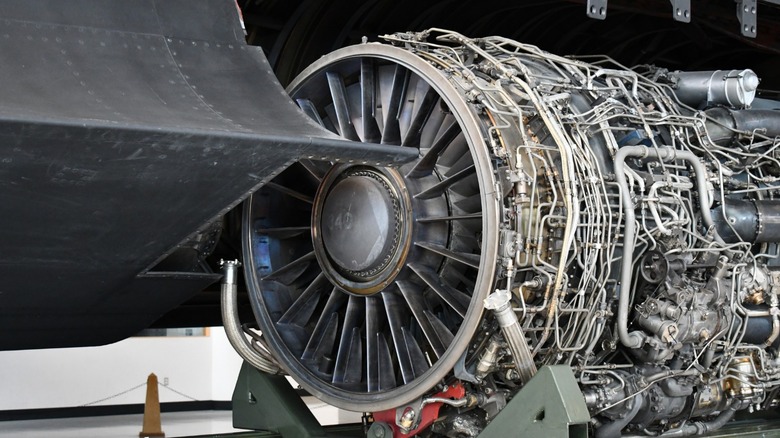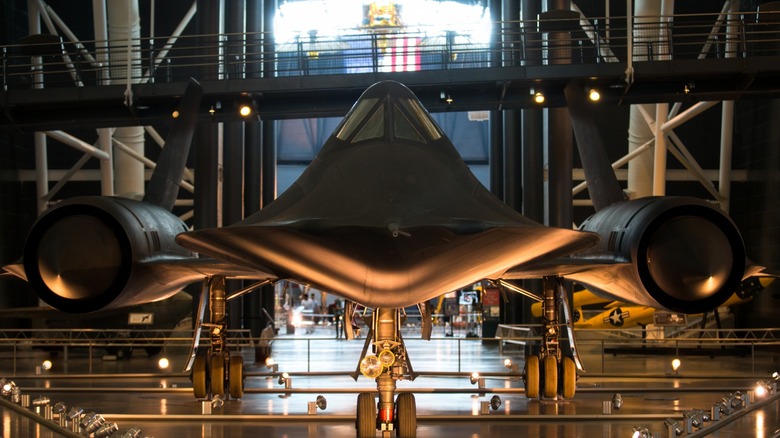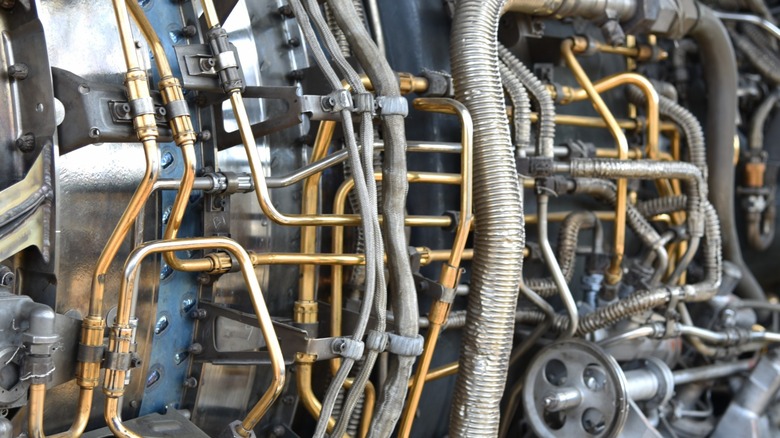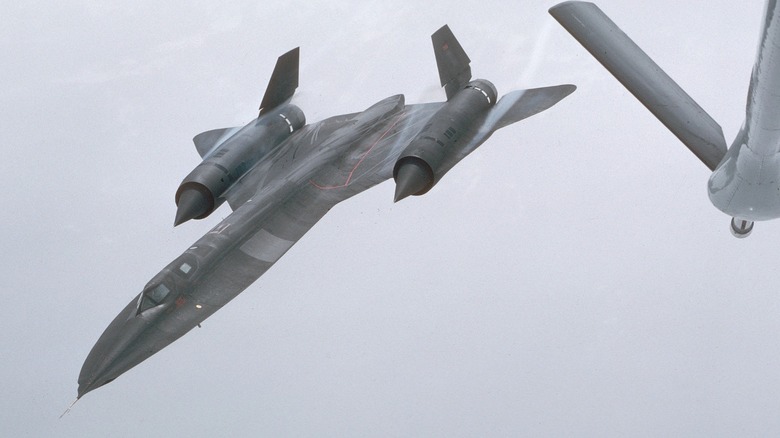Everything To Know About The J58 Turbojet Engine Powering The SR-71 Blackbird
When it comes to blistering aerial speeds, fighter jets manufactured by American military contractors like Boeing and Lockheed dominate the skies. While Bell's X-1 "Glamorous Glennis" was the first plane to break the sound barrier and go faster than Mach 1 in 1947, U.S. Air Force's Ed Yeildling and Joseph Vida would more than double that in 1990, traveling at a blistering 2,124 miles per hour in a Lockheed Martin SR-71 Blackbird.
While the sleek form factor of the Blackbird makes it one of the most recognizable reconnaissance aircraft ever constructed, the two Pratt & Whitney J58 Turbojet Engines that power the jet are what actually enable the amazing aircraft to reach those record-setting speeds. Though the first flight for the SR-71 Blackbird would occur in 1964, development for the turbojet engine powering the craft began six years earlier.
Through an array of engineering innovations and enhancements, engineers from Pratt & Whitney constructed the first turbojet-style engine to sustain Mach 3 speeds for extended periods. However, it wasn't easy to pull off, and it required the use of engineering knowledge gained through decades of developing the fastest jet engines in the world.
The J58 Turbojet was designed for the Cold War
Development for the Pratt & Whitney-designed J58 turbojet engine began in 1958. At the time, the United States Navy sought a fast reconnaissance jet, though it would later be the U.S. Air Force's SR-71 that would eventually use the new engine. Tensions due to the Cold War had American officials scrambling to develop a way to monitor and assess Soviet military deployments, particularly around the Iron Curtain.
The American military's jet for reconnaissance at the time was the Lockheed U-2, powered by the Pratt & Whitney J57 turbojet engine. This iteration of the aircraft would be deemed too slow and left the U-2 and its pilots vulnerable to Soviet missiles and interceptor aircraft, as demonstrated when a U-2 was shot down by a surface-to-air missile in 1960. The lack of an alternative would lead to the development of an aircraft and engine capable of obtaining speeds of Mach 3+ at 80,000 feet or higher.
Though there were a variety of aircraft considered for the J58, like the Convair Kingfish, ultimately, it would be utilized in four planes: the Lockheed A-12, SR-71, SR-71B trainer aircraft, and YF-12A prototype, the latter of which only had three manufactured ever. Production on the finalized version of the J58 started in 1964, with the first SR-71 taking its first flight on December 22 of the same year.
J58's engine design was innovative
The immense heat generated from jet engines was the main issue for engineers when attempting to develop an aircraft capable of going three times the speed of sound. This requirement demanded innovative design techniques not only for the aircraft itself but also for the engines that powered it.
Engineers at Pratt and Whitney tackled this issue by developing an 8-stage axial combustor with a compressor bleed function that enabled the J58 to remain operational at temperatures above 750 degrees Fahrenheit. This innovation would allow the SR-71 to continuously use its afterburner for extended periods, thus enabling the craft to maintain supersonic speeds over immense distances.
More technically, the single-shaft rotor J58 would open bypass valves that bled air from the fourth stage through six tubes that routed the air around the turbine, combustor, and rear stages of the engine. This air would re-enter the turbine exhaust at the front of the afterburner, improving the thrust and cooling.
The J58 had good gas mileage at Mach 3 speeds
Though it would seem counter-intuitive, innovations with the J58 engine gave the Blackbird the best "gas mileage" during Mach 3+ cruise speeds. The need to slow down to subsonic speeds to refuel at lower altitudes caused a cooling effect that caused the aircraft's skin panels, including those covering the fuel tanks, to shrink. This contraction would lead to fuel being leaked from the tanks, forming a memorable vapor trail behind the aircraft.
In total, each Pratt & Whitney J58 Turbojet engine weighed in at 8,690 pounds and was a massive 6.8 feet wide and 20 feet long. Capable of reaching up to 30,000 pounds of thrust per engine, the innovations made with the engine would go on to inspire future designs like the Pratt & Whitney TF30 Turbofan, which powers General Dynamics F-111, the F-14A Tomcat, and Corsair II, among other aircraft.
The final flight of the SR-71 Blackbird carrying a J58 would occur on March 6, 1990, with a record-setting flight. USAF pilots Ed Yeildling and Joseph Vida flew from Los Angeles, California, to Washington, D.C., in only 1 hour and four minutes, averaging a speed of 2,124 miles per hour. This final record-setting trip would mark the end of the SR-71's active service after 22 long years.



